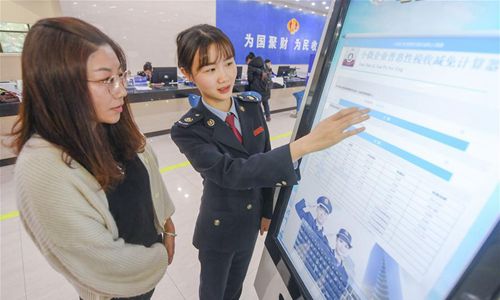
A staff (R) explains to a taxpayer about a new policy on VAT reduction at a local tax bureau in Fengze District of Quanzhou, southeast China's Fujian Province, April 1, 2019. Starting on April 1, companies that are subject to the 16-percent VAT rate on their taxable sales or imported goods will enjoy a 13-percent VAT rate, while those who are subject to the 10-percent VAT rate will only need to pay 9 percent, reads a Ministry of Finance statement. (Photo:Xinhua)
Chinese provinces have reported a fast recovery in their fiscal revenues during the first quarter of the year, with collections returning to pre-pandemic levels while transfers for fiscal spending accelerated to provide support for public welfare, the Economic Daily reported on Wednesday.
Chinese finance experts said that the revival is a clear indication of the sustained momentum of China's economic recovery. But they warned that fiscal conditions for the provinces could shift to low- to medium-speed growth during the remaining months of the year, amid rising financial pressure from local government debt.
Multiple provinces posted high annual growth rates of more than 20 percent during the first three months, public data showed.
East China's Zhejiang Province posted a fiscal revenue of 275.7 billion yuan ($42.6 billion), up 27.5 percent year-on-year, while neighboring Jiangsu Province saw its fiscal revenue grow 24.9 percent to reach 277.61 billion yuan.
Value-added tax and corporate income tax now become the main growth drivers of rising revenues.
He Daiqin, an expert in fiscal finance with the National Academy of Economic Strategy at the Chinese Academy of Social Sciences, attributed the fiscal revenue growth to sustained economic recovery, with production and consumption returning to pre-pandemic levels.
The strong data also reflected a relatively low base in 2020, a rise in commodity prices during the quarter and an expansion in the growth of the domestic producer price index (PPI).
Meanwhile, fiscal spending steadied and funds were allocated swiftly, and analysts said fiscal spending was returning to normal as the country implemented regular virus prevention and control measures.
Fiscal expenditure on some pivotal fields, including education, employment and public health, saw substantial increases.
Most transfers of direct fiscal funds, which aimed to benefit businesses and the public, were completed during the first quarter, He said.
China plans to include 2.8 trillion yuan worth of central government fiscal funds, up 1.1 trillion yuan from 2020, into direct fiscal funds investment mechanism in 2021, according to the Government Work Report.
Local Chinese governments continue to run tighter budgets, and finance experts warned their fiscal revenues and spending will be tight despite the recovery seen in the first quarter.
Headwinds are likely to come from the interest payments on existing local government debt, the global economy's downward pressure, and pressure from the central government's massive tax and fee cuts to protect middle and small enterprises, He said.
Experts said that provincial governments should beef up their budget management in light of anticipated low- and medium-speed fiscal growth during the coming months of the year, and try to reduce newly added hidden debts and avoid reckless expansion of budgets.



